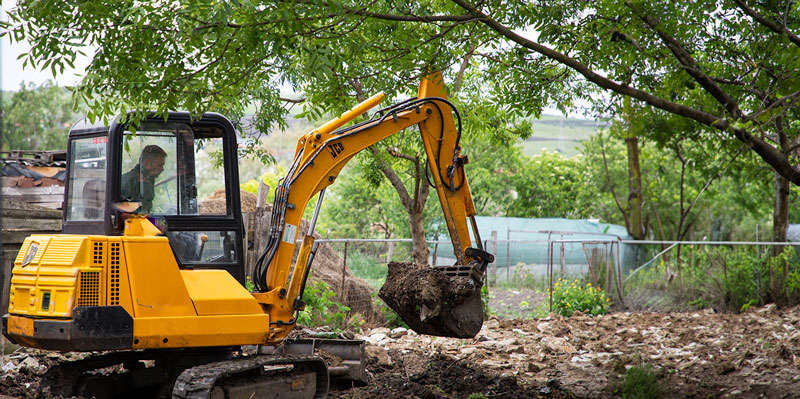The electrification of construction machinery is an increasingly important trend in the construction industry. Stricter environmental regulations, rising fuel prices and technological advances are rapidly increasing the acceptance of electric construction machinery. This article looks at the current developments, technological advances, challenges and future prospects in this sector.
Market development and growth in Germany
The German market for electric construction machinery is developing dynamically. The German government's ‘Climate Protection Programme 2030’ and the EU target of climate neutrality by 2050 in particular are increasing the pressure on the construction industry to implement low-emission technologies. A growing proportion of construction machinery manufacturers are investing in electrified models in order to meet the stricter emission standards.
According to current market analyses, the demand for electric construction machinery in Germany is rising steadily. The German government is promoting this development through various programmes, including
- BAFA-subsidy for climate-friendly commercial vehicles: companies can receive subsidies for the purchase of low-emission or emission-free machines.
- KfW-programmes for financing sustainable construction projects: Electric construction machinery is eligible for funding if it is used in sustainable construction projects.
- Municipal initiatives in Berlin, Hamburg and Munich: These cities are increasingly focussing on emission-free construction sites and creating incentives for companies to use electric machines. Construction companies themselves are also actively driving the changeover. Companies such as Liebherr, Wacker Neuson and Volvo CE are increasingly presenting fully electric machines and investing in research into more powerful batteries and alternative drive technologies such as hydrogen.
Technological advances
Battery life and charging infrastructure
The first generation of electric construction machines had operating times of four to six hours. Models with up to eight hours of running time are now available, which can cover an entire working day. Running times of nine to ten hours are expected in the near future, which will further increase their competitiveness compared to diesel machines. At the same time, the expansion of the charging infrastructure remains a challenge, particularly on large construction sites.
Performance and efficiency
Modern electric mini excavators already achieve 30-60 % more digging force than comparable diesel models. Larger construction machines such as wheel loaders and crawler excavators are now also available in electric versions, which considerably expands the range of applications.
Innovations and new concepts
E-native maschines
E-native machines are construction machines specially developed for electric operation. They are based on a completely new design that is optimised for electric mobility. This includes an improved battery capacity, reduced use of hydraulics in favour of more efficient electrical systems and a lower dead weight, which has a positive effect on energy efficiency. Manufacturers are also working on further optimising the control and maintenance of these machines through digital interfaces.
Hybrid drive systems
Hybrid drives combine electric motors with conventional combustion engines to ensure a longer service life. There are now various hybrid concepts, including serial and parallel hybrids. Serial hybrids use a small combustion engine as a generator to charge the battery, while parallel hybrids can switch between electric and conventional drive. This technology is particularly relevant for large construction machines, which have high performance requirements and need to reduce fuel consumption and emissions at the same time.
Alternative sources of energy
In addition to pure battery technology, intensive work is being carried out on alternative energy sources. Hydrogen-powered construction machinery is a promising option, particularly for use in remote areas where a charging infrastructure is difficult to realise. Fuel cells are used to convert hydrogen into electrical energy. Biofuels are another alternative that enables a gradual reduction in fossil fuels without completely replacing existing machinery.
Challenges
Despite the positive development, the electrification of construction machinery still faces a number of challenges:
- High acquisition costs: Elektric construction machines are generally more expensive than their diesel-powered counterparts. However, investments are amortised through lower operating costs and government subsidies.
- Charging infrastructure: The development of a comprehensive charging infrastructure is a key prerequisite for broader market penetration. This is a particular challenge for large-scale construction sites.
- Battery technology: Battery technologyAdvances in battery technology are required to achieve longer running times, shorter charging times and a higher energy density. The recycling and sustainability aspects of batteries are also an important aspect of research.
Driving forces behind electrification
Environmental regulations
Stricter emissions regulations at national and international level are encouraging the switch to electric drives. These regulations are putting pressure on companies to develop and utilise more sustainable alternatives. At the same time, environmental certificates and CO2 reduction targets are important incentives for construction companies to invest in emission-free machines, while urban initiatives in metropolises such as Oslo, Copenhagen and London are aiming for climate neutrality between 2025 and 2030. In Germany, large cities in particular are focussing on zero-emission construction sites. Berlin has already launched pilot projects with fully electric construction machinery, and Hamburg is planning stricter regulations for the use of low-emission construction machinery in the building industry.
State subsidies
In addition to the already established BAFA and KfW programmes, there are an increasing number of regional initiatives to support electrification in the construction industry. These subsidies make it easier for companies to switch to more sustainable technologies and compensate for the initially higher costs of electric construction machinery.
Summary
The electrification of construction machines The electrification of construction machinery will continue to accelerate in the coming years. Manufacturers are investing heavily in research and development in order to improve the performance and efficiency of electric machines. In addition to technical advances, regulatory measures and economic incentives are also crucial for market penetration. Despite challenges such as high acquisition costs and a lack of charging infrastructure, development is clearly focussed on more sustainable, quiet and clean construction site operations.
